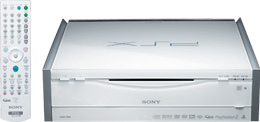In the past year or so, there has been a lot of speculation about the Phantom console. The name doesn’t help much, it has to be said. The console was announced early in 2003 and then everything went a bit quiet – no prototypes were seen, the platform itself seemed a bit vague and many regarded Timothy Roberts’, the man behind Infinium Labs, involvement as a bad omen.
For some months, the only images of the console were 3D renders, and no games developer has yet admitted to having signed up for the platform.
The console was finally unveiled at the last CES, and we’d like to gather what is known about Phantom to clear up some of the mystery.
[1] What’s in it?
Infinium state that the console is PC-based and features a custom N-Force motherboard. The processor is listed as “up to AMD XP 3200+”, though whether that this implies that the box is customisable or upgradable, or they just haven’t finalised it yet, no-one knows. The really important part, the graphics chipset is around the GeForce FX5700 mark. Interestingly, the console does not feature an optical drive, but will feature a hard drive up to 320gb in size.
[2] What does it run?
The Phantom runs on a modified Windows XPe kernel.
[3] What will it cost?
We’ve seen figures for between ~US$400 and ~US$700, which places it firmly in the “cheaper than a PC for playing games, but considerably more than a console” bracket.
[4] What can you play on it?
The Phantom will come with pre-installed games. Some reports have said as many as fifty. Other games will be available for download through the PhantomNet GameService.
Given the hardware/software platform, the games will be modified versions of PC games.
[5] What is PhantomNet GameService?
The console is unique in that it requires a broadband connection to function – players will be able to download new games or activate licenses for those already preloaded on the hard disk. Presumably, the service will also provide other functions as seen on Sony’s Central Station and Microsoft’s Xbox Live.
[6] Does it stand a chance?
Well, that remains to be seen. Xbox and Playstation2 are obviously dominating the market (and so will their offspring), and we’ve seen previously unassailable leaders like Sega and Nintendo get badly burned with hardware. However, the Phantom is a essentially a PC (and even more of a PC than the Xbox isn’t), so isn’t entirely proprietary like the GameCube and, to a slightly lesser extent, the Dreamcast. And remember, everybody laughed at Sony in 1995.
One of the problems we can see is the implication that consoles will be built to order, making standardisation a problem. However, new games can be published to the format without too much redevelopment and, given the absence of an optical drive, piracy will be difficult.
This could be a terrific distribution channel for games publishers who can’t get space in big retailers, or can’t afford the heavy discounting that’s endemic in the market. It could also be a great service for buying games on impulse, when even Amazon isn’t fast enough.
Given the dramatic increase in broadband subscriptions, the console could be right on time – but given that many games now have installers measuring 500 mb to 2 gig in size, perhaps popping down the shops to buy Half Life2 might be quicker than downloading it, although that didn’t put someone off in the past.
[7] What next?
Curiously, Infinium are reluctant to tell the press much at this stage, even though the project is reportly in advanced stages. They have, however, managed to raise a not inconsiderable amount of venture capital (at least ~US$25 million) on the back of this idea – despite not having really shown anyone anything.
We’ll keep you posted.
Wired on the Phantom
HardOCP on Infinium’s patchy history
Infinium on the Phantom
 Following the recent launch of Sony’s PSX, which combines the functions of a PlayStation 2, PVR and DVD burner (
Following the recent launch of Sony’s PSX, which combines the functions of a PlayStation 2, PVR and DVD burner ( Back in September this year, Nintendo announced they would be creating a home games console that would sell exclusively in Chinese market. Initially to be sold in Shanghai, Guanzhou and Chengdu, this will be the first games console to be sold in China.
Back in September this year, Nintendo announced they would be creating a home games console that would sell exclusively in Chinese market. Initially to be sold in Shanghai, Guanzhou and Chengdu, this will be the first games console to be sold in China.